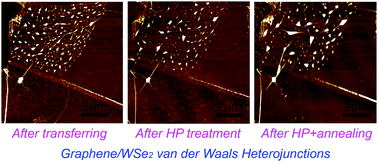A high-pressure enhanced coupling effect between graphene electrical contacts and two-dimensional materials thereby improving the performance of their constituent FET devices†
Abstract
Defects, such as bubbles and wrinkles, are inevitable at the interface of the van der Waals heterojunctions (vdWHs) formed by transferring two-dimensional (2D) materials. These defects weaken the coupling of the constituents of vdWHs, resulting in deterioration of the performances of their based field effect transistor (FET) devices. Herein, we have proposed a feasible and scalable method to efficiently reduce or remove the bubbles and wrinkles at the interface of the vdWHs by combining high-pressure treatment and thermal annealing. AFM images show the morphology evolution of bubbles and wrinkles after each step, indicating that a larger clean interface is achieved. Raman spectra reveal a strong coupling between the 2D material heterojunction after high-pressure treatment. The extended clean interface and enhanced coupling will improve the electrical performances of FET devices. For single-layer WSe2 based FETs, the on-current can be improved by ∼1200× after the high-pressure treatment and thermal annealing, while the off-current remains at the same level as before, leading to a high on/off ratio of 1 × 106. Meanwhile, the hole mobility is improved by ∼356× up to 504.2 cm2 V−1 s−1. Furthermore, the proposed method could be feasible for other 2D material based FET devices, such as MoS2 and SnS2, which shows a universal proposal for improving devices’ electrical performances.



 Please wait while we load your content...
Please wait while we load your content...